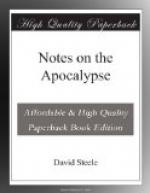The “sealed book” being delivered by the Father into the possession of the Mediator, the whole creation awaits with confidence and joy the development of the counsels of God, as they may affect the destinies of his redeemed people. The “Lamb has prevailed to open the book,” and his established character is sufficient guarantee for success in accomplishing the responsible work assigned him by his Father. This feeling of confidence is expressed by the worshippers, not only by the matter of their praise, but also by the closing word, “amen;” which word is expressive of their “desires and assurance to be heard.”
CHAPTER VI.
1. And I saw when the Lamb opened one of the seals; and I heard, as it were the noise of thunder, one of the four beasts saying, Come and see.
2. And I saw, and behold a white horse: and he that sat on him had a bow; and a crown was given unto him: and he went forth conquering, and to conquer.
Vs. 1, 2.—The apostle “saw when the Lamb” proceeded to disclose the contents of the book by breaking the seals in regular succession. It is not requisite to suppose that each of the seals covers an exactly equal part of the roll. These parts may be quite different in quantity or length. It is obvious, however, that upon the breaking of any one seal, that part of the roll which the seal was intended to cover, would be disclosed to a spectator’s view,—the whole of such part and no more. We shall find as we advance that the several parts of this book are in fact very different in extent. When the seventh and last seal is opened, the whole contents of the book must of course be disclosed: and it will appear that the last of the seals contained a much greater part of the roll than any of the others. To a superficial reader this may be apparent from the circumstance that within the compass of this short chapter, six of the seals exhibit their contents.
By the most learned and sober divines the first six seals are considered as disclosing the events which transpired from the time of the apostle John till the overthrow of pagan idolatry in the Roman empire and the accession of Constantine.
Let us consider the contents of these seals in order: Upon the opening “of one of the seals,” the first of course, “one of the four animals” with a voice like “thunder, said, Come and see.” This was the animal like a “lion,” emblematical of those bold and dauntless servants of Christ who took their life in their hand and “went every where preaching the word,” (Acts viii. 4.) Many expositors, of secular notions and affinities, imagine that some one of the Roman emperors is to be understood as represented by him who rides on the white horse,—Vespasian, Titus, or Trajan. To name such figments is enough to confute them in the mind of such as have spiritual discernment. “White” is not the divinely chosen symbol of bloody warriors or persecutors.




